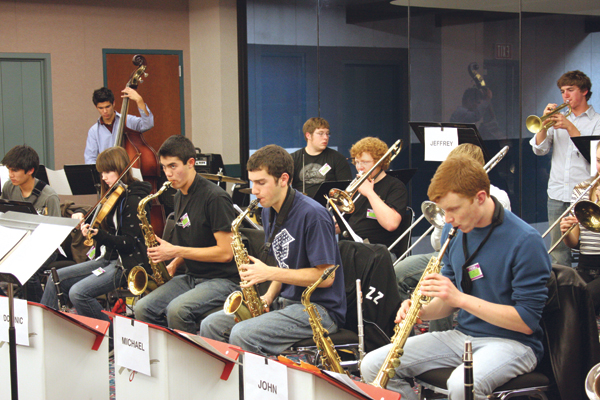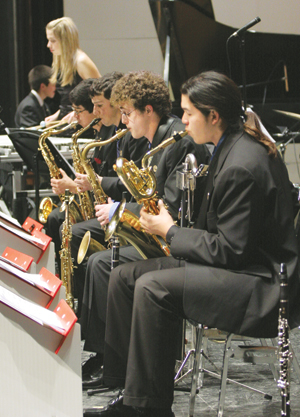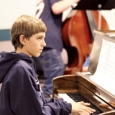
No ensemble is easier to form and has more variation than a jazz ensemble. This can be a jazz combo or a full jazz band. Begin filling out the rest of the rhythm section before going after horn players. The first person to recruit is a drummer; it is highly unlikely that no one at all will be interested in playing the drumset, so this should be easy to find. When a set drummer has been found, the next person to locate is someone to play the bass line. If a bassist cannot be found, a piano player can play the bass lines for the jazz ensemble. Check the library for charts with piano parts that double the bass line; these are ideal choices for an ensemble with no bassist, because the pianist can cover both parts without any rewriting. Directors lucky enough to find two piano players can have one play the piano part and the other playing a synthesizer with a bass setting. Guitarists will be easy to find. It may be necessary to teach them to read music, but of more importance is helping them to understand the jazz chords and voicings in the music.
Finding Enough Horns
The minimum instrumentation for a jazz ensemble is one alto saxophone, one tenor saxophone, one trumpet, and one trombone. This combination makes it possible to cover both the melodies and harmonies in easy charts, although two trumpets, a tenor saxophone, and a trombone is another good option. Some publishers offer charts that are playable with minimal instrumentation but also provide options for adding more players.
Sometimes there may be almost a full jazz ensemble, with only a second tenor sax player or fourth trombone player missing. There are a number of options for filling in missing instruments. Of the three horn sections, the trumpet section is usually the easiest to fill, but if a fourth player is needed, horn is the best choice to cover the fourth part because it will blend best with the section. If the position of the bell causes difficulty, consider using a mellophone to direct the sound toward the audience. The other option is to cover the fourth trumpet part with a clarinet player, although blend can be difficult, especially when the clarinet is in the weakest part of its range.
 A missing second alto sax part can be covered by a flute player, although the part will require rewriting. Flutes will be able to project and match the range, but blend can be difficult to get right. When considering middle music, flute is going to be in roughly the same range as the alto, and the fingerings will line up pretty closely, too. Use a flutist to fill the spot with the aim of getting the student interested enough in jazz to learn to play saxophone; this gives the group an eager woodwind doubler. A second tenor sax part can be covered by a clarinet player. Clarinets blend well with a saxophone section and although the sound octave is different, the transposition is the same, which means the part will not need rewriting.
A missing second alto sax part can be covered by a flute player, although the part will require rewriting. Flutes will be able to project and match the range, but blend can be difficult to get right. When considering middle music, flute is going to be in roughly the same range as the alto, and the fingerings will line up pretty closely, too. Use a flutist to fill the spot with the aim of getting the student interested enough in jazz to learn to play saxophone; this gives the group an eager woodwind doubler. A second tenor sax part can be covered by a clarinet player. Clarinets blend well with a saxophone section and although the sound octave is different, the transposition is the same, which means the part will not need rewriting.
The trombone section of a jazz ensemble is often the most difficult to fill. A valve trombone is an ideal substitution, because any other brass player can learn the instrument quickly and the blend will be the same. As students improve on valve trombone, they may be able to switch over to slide trombone with greater ease. If valve trombones are unavailable, euphonium players can cover the third or fourth trombone parts. The only difficulty with euphoniums is blending the sound. Bell-front baritones blend better than upright euphoniums, so a euphonium player should switch to a bell-front horn if one is available.
A tuba player will usually be able to handle a fouth trombone part. The tuba has a lot of history as a jazz instrument; it was one of the original jazz instruments in Dixieland music. When big bands gained prominence in the 1930s and 40s the tuba was replaced by the bass, although they were occasionally used as a fourth or fifth trombone part. Many fouth trombone parts go low enough for the tubist to play the music as written, and high parts can be taken down an octave as needed. Tuba players have to learn to make good decisions about when to read the part as written and when to take it down an octave. Tubists should also play everything extremely short and separated; it is easy for a young tubist to play too heavily and bog everything down. When using a tuba player, look for charts that put fourth trombone and bari sax together frequently because these instruments blend well and produce a rich sound.
Organizing Classes
As a middle school teacher, I tried to build a jazz ensemble for each grade. This produced a steady stream of students and good instrumentation and made it possible to teach styles and improvisation over multiple years. Having students play together for many years improves good ensemble communication as well. I never turned away a middle school student who wanted to play, even if I already had six second tenor saxophone players. The aim of the ensembles was to introduce students to jazz. Many students continued their jazz studies in high school and beyond.
When starting a jazz program, first find the music to be played that first year. Repertoire should focus on the classics; there are many easy-to-play jazz charts that are written just the way they were played by Ellington and Basie, and they are easy for first-year players. The music should be for flexible instrumentation, stay in safe keys, and have easy melodies. Prepare listening examples for these charts. Having students listen to jazz helps ingrain how this style of music is played and gets the imagination going.
With my classes we spent the first year on the history of jazz and then a year with students focused on their instruments. It is important for all first-time players, not just the pianists, to know about Duke Ellington. Every section of the ensemble plays great in these recordings, so students still learn how their instruments should sound as part of a group. My list of recommended CDs would come from a couple of the greats in each of the styles. One of the most important aspects of listening is to master style. Students have difficulty understanding how the notes on the page should sound in a given jazz style. I always think of Satin Doll, which is easy to teach but difficult for beginners to interpret.
I start teaching improvisation right away but limit students’ choice of pitches. I let them pick any kind of rhythm but they are only allowed to play the tonic. Students often forget not to play; they feel every beat has to have music. When they have limited options, they can rest and not play. The aim is for students to improvise musically rather than spew an endless stream of notes.
By the end of the first year they can choose roots and thirds at the most. I spend time teaching students to hear the changes and know at any point where they were in the form. If students are lost, nothing else they know matters. Over time we would expand permitted notes to 1-3-5, and discuss how 2-4-6 were blue notes that should not be sustained. By the third year, many students could improvise quite well and feel comfortable doing so.
As the Jazz Program Grows
While teaching in high school, I was fortunate enough to have a jazz class during the school day. Once the first students were hooked they started recruiting friends. Eventually I had beginning and advanced jazz classes based around jazz combos, which allowed for flexible instrumentation and made it easy to group students by ability within each class. A third jazz ensemble for students who could not fit in another class during the day met after school. For directors who cannot schedule a jazz class during the school day, it is better to have multiple short rehearsals after school than one three-hour rehearsal once a week.
Three one-hour rehearsals will produce better playing than one long rehearsal, and students are more likely to remember things from one rehearsal to the next. This is especially beneficial in getting a rhythm section members to play well together.
The decision of whether to have auditions or accept everyone depends on the program a director wishes to build. When starting a jazz band for the first time it is better to make the group open to everyone and get as many students involved as possible. When jazz increases in popularity, many schools go to an audition process, at least for seating.
One year after 50 students, half of whom were unexpected, showed up for jazz auditions, I realized I would be cutting enough students to form another whole jazz ensemble. At that point I split students into a one-on-a-part top band that met multiple times during the week. The other group I kept open with multiple players on a part, a trumpet section of six or seven, and eight or nine in the sax section. This gave me an advanced top group with exact instrumentation and a secondary group in which I could introduce students to jazz styles and improvisation and teach them the specifics of playing in the sections of a jazz ensemble.
I had reached the point at which I had a feeder program for my ensemble and could see the effects of my curriculum planning and lessons. Seeing the enthusiasm of that open band was a good reminder of how much fun it is playing something for the first time. Starting a jazz band had been well worth the effort.






